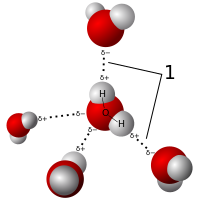
Photo from wikipedia
Abstract Hydrogenation in liquid phase is a competitive process for converting asphaltene to distillate with minimum coke formation compared with thermal cracking. Some Industrial distillates, which contain rich naphthenic aromatics,… Click to show full abstract
Abstract Hydrogenation in liquid phase is a competitive process for converting asphaltene to distillate with minimum coke formation compared with thermal cracking. Some Industrial distillates, which contain rich naphthenic aromatics, are a suitable substitution serving as inexpensive industrial distillates hydrogen donor. In this paper furfural extract oil with boiling point of 430–450 °C was selected as industrial distillate hydrogen donor. The liquid-phase liquefaction behaviors of asphaltene with industrial distillates hydrogen donor were investigated in an autoclave. The effects of reaction conditions, including reaction temperature and time, on product distributions and selectivity were studied. The results showed that the asphaltene conversion and coke yield increased with the reaction severity increasing. However, the selectivity of maltene decreased with the reaction severity increasing. Two kinetic models were developed for describing the behavior of liquid-phase liquefaction of asphaltene. In model one, which was only considering the reaction of asphaltene conversion, asphaltene liquefaction was in good agreement with the first-order reaction kinetic with apparent activation energy of 106.09 kJ mol−1 under the condition of coke yield less than 3 wt%. In model two, a four-lump kinetic model including asphaltene, maltene, gas, and coke lumps, the activation energies varied from 100.14 to 117.58 kJ mol−1. The product yield predicted by the developed four-lump kinetic model exhibited good consistency with the experimental data. Additionally, the kinetic model two can well predict the reaction behavior with relative error lower than 4%.
Journal Title: Fuel
Year Published: 2017
Link to full text (if available)
Share on Social Media: Sign Up to like & get
recommendations!